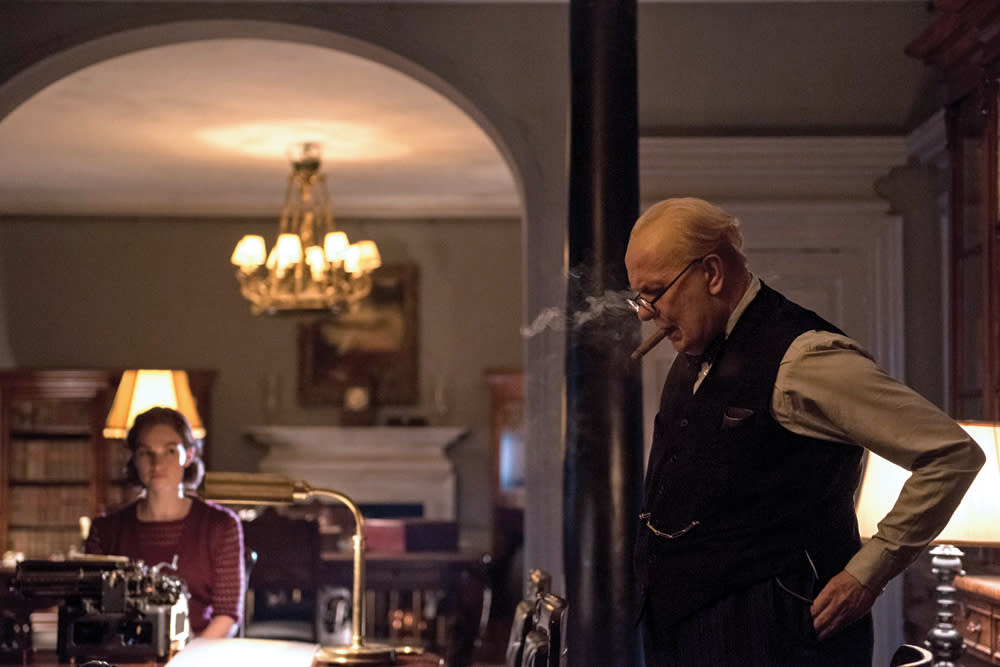Crew Creates Shabby-Chic World War II London for ‘Darkest Hour’

Sarah Greenwood
production designer
Jacqueline Durran
costume designer
Production designer Sarah Greenwood and costume designer Jacqueline Durran have worked on seven films together spanning a diverse visual spectrum — most of them for director Joe Wright. These include “Atonement” (2007), “The Soloist” (2009), “Hanna” (2011) and “Anna Karenina” (2012). By all indications they’ve stayed very busy of late, having collaborated on two of this year’s awards contenders: the Bill Condon-directed “Beauty and the Beast” and Wright’s latest film, “Darkest Hour,” starring Gary Oldman as Winston Churchill in the period surrounding the Battle of Dunkirk during World War II.
Greenwood — a born-and-bred Londoner — describes working as part of a creative team on a Wright’s movie as being a member of a big, dysfunctional family — albeit one whose members have an easy shorthand and a distilled knowledge of each other’s working habits. Dysfunctional or not, they’ve hit many high marks.
“Sarah, as a production designer, is always on board any project earlier than I am,” says Durran, who took home an Oscar for her costumes in “Anna Karenina.”
“One of the first things I do when starting a job is meet with her to go through the design world that she has already started creating. The framework that Sarah builds for each project is one of the foundations that I base my ideas upon.”
In the early going, Greenwood and Wright spend time honing in on his vision for the project at hand.
“Joe is great to work with,” says Greenwood, who has garnered three Oscar nominations on Wright’s films. “He might kill me for saying this, but it’s like panning for gold. There are always fantastic ideas in there somewhere and you’ve just got to rustle them out.”
The visual goal on “Darkest Hour” was to create a believable world of 1940s Britain. “It was very much a make-do-and-mend world,” Durran recalls.
As in “Beauty and the Beast,” which they worked on a year earlier, “Hour” juxtaposes worlds of light and darkness, which collide as the story progresses.
There were several images that helped guide the environment they aimed to recreate. They took inspiration from many period photographs, including an image of English heiress and socialite Lady Edwina Mountbatten in uniform and with heavy makeup, her hair in an aristocratic but shabby style.
It was this combination of shabby and chic that Greenwood and Durran keyed in on.
“There was something quite tawdry about it,” says Greenwood of the photograph. “Even though it was a very obviously in a grand house, it was dirty and sooty, a bit grim. [We wanted] to capture how grim it was.”
Greenwood re-created a set of Churchill’s underground war room, some of which still remains today as a museum. She and her team pinpointed references from it — including its low ceilings, paint textures and tonalities — then made the space work for camera moves.
“If you remember ‘Downfall,’” says Greenwood referring to the 2004 film about Hitler’s last days in his bunker, “this was polar opposite. Everything about that was hard and sharp, cool gray, very precise — the way the German’s did [things]. The British, well everything was completely cobbled together last-minute.
“That’s the feeling that we wanted to get across.”
Related stories
'Darkest Hour,' 'Three Billboards' Among Films Not Eligible for WGA Awards
Oscars: Best Actor is a Race to Lose to Gary Oldman... Or is It?
Production Designers Bring to Life Past and Future Worlds
Subscribe to Variety Newsletters and Email Alerts!

